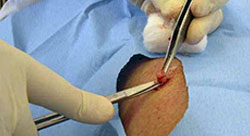Moles are blemishes that appear on the skin. A lot of times they are small bumps or raised skin that is easily visible to the naked eye. The fact that they are visible is what pushes most people to want to remove them. Although benign moles don’t pose any real health risk, people tend to get them removed for cosmetic purposes. Mole removal can also help a person get rid of the constant itching and swelling associated with moles in bothersome places like the underarms or waistband. Others may have experienced social trauma because of their skin conditions and are seeking solace through surgery. The only way to get rid of a mole is by choosing to have a mole removal procedure done.

What Are Moles?
The majority of people call any type of dark spot a mole, however, this isn’t always the truth. There are a wide variety of different skin marks that, although they might seem like moles, are not moles by definition. Physicians use terms to identify and differentiate all of them. Some of these marks include:
- Hemangiomas
- Keratoses
- Birthmarks
- Moles
Keratoses are somewhat like moles in the sense that are usually benign rather than malignant. They usually start to appear once a person has grown beyond the age of thirty. Scientifically, moles are known as melanocytic nevus and they are considered to be lesions. It has been proven that exposure to the sun may speed up the proliferation of moles, which under less than ideal circumstances will become malignant and need surgery.
Types of Mole Removal Procedures
Before deciding on what mole removal procedure you need to have done you should visit your dermatologist in order to examine you.It’s important for you to become familiar with the different methods that can be used for the proper removal of your mole. These include:
- Excision (deep) – the surgeon cuts deeply in order to extract the mole
- Excision (shave) – the surgeon makes use of a tool to shave off parts of the mole
- Cauterization – the surgeon uses super-hot steel to burn off the mole with a special cauterization tool
- Biopsy – the surgeon makes use of a tool that resembles a cookie cutter to pull off the mole. Usually performed when tests are being run on the mole
- Laser – the surgeon uses low-intensity lasers to burn off moles while cauterizing immediately
ABCs of Melanoma
Prior to having a mole removal procedure done, it’s the surgeon’s responsibility to determine accurately if the mole is malignant or not. In order to do to this, a biopsy can be performed where a small sample of the skin on the mole is taken. There is also a technique known as the ‘melanoma ABCDE’ that can help you identify the symptoms of melanoma:
- Asymmetrical lesion of the skin
- Border of the lesion is irregular
- Color – malignant moles are likely to have different colors
- Diameter – 6mm and larger pose a risk
- Evolution – if the mole tends to grow or you’ve seen it raised higher than usual
